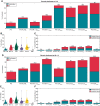Personalized ablation vs. conventional ablation strategies to terminate atrial fibrillation and prevent recurrence
- PMID: 35943361
- PMCID: PMC9907752
- DOI: 10.1093/europace/euac116
Personalized ablation vs. conventional ablation strategies to terminate atrial fibrillation and prevent recurrence
Abstract
Aims: The long-term success rate of ablation therapy is still sub-optimal in patients with persistent atrial fibrillation (AF), mostly due to arrhythmia recurrence originating from arrhythmogenic sites outside the pulmonary veins. Computational modelling provides a framework to integrate and augment clinical data, potentially enabling the patient-specific identification of AF mechanisms and of the optimal ablation sites. We developed a technology to tailor ablations in anatomical and functional digital atrial twins of patients with persistent AF aiming to identify the most successful ablation strategy.
Methods and results: Twenty-nine patient-specific computational models integrating clinical information from tomographic imaging and electro-anatomical activation time and voltage maps were generated. Areas sustaining AF were identified by a personalized induction protocol at multiple locations. State-of-the-art anatomical and substrate ablation strategies were compared with our proposed Personalized Ablation Lines (PersonAL) plan, which consists of iteratively targeting emergent high dominant frequency (HDF) regions, to identify the optimal ablation strategy. Localized ablations were connected to the closest non-conductive barrier to prevent recurrence of AF or atrial tachycardia. The first application of the HDF strategy had a success of >98% and isolated only 5-6% of the left atrial myocardium. In contrast, conventional ablation strategies targeting anatomical or structural substrate resulted in isolation of up to 20% of left atrial myocardium. After a second iteration of the HDF strategy, no further arrhythmia episode could be induced in any of the patient-specific models.
Conclusion: The novel PersonAL in silico technology allows to unveil all AF-perpetuating areas and personalize ablation by leveraging atrial digital twins.
Keywords: Atrial fibrillation; Computational model; Digital twin; Electro-anatomical mapping; MRI; Personalized ablation.
© The Author(s) 2022. Published by Oxford University Press on behalf of the European Society of Cardiology.
Conflict of interest statement
Conflict of interest: The authors declare that the research was conducted in the absence of any commercial or financial relationships that could be construed as a potential conflict of interest.
Figures







References
-
- Duytschaever M, Vijgen J, De Potter T, Scherr D, Van Herendael H, Knecht S, et al. . Standardized pulmonary vein isolation workflow to enclose veins with contiguous lesions: the multicentre VISTAX trial. EP Europace 2020;22:1645–52. - PubMed
-
- Verma A, Jiang C, Betts TR, Chen J, Deisenhofer I, Mantovan R, et al. . Approaches to catheter ablation for persistent atrial fibrillation. N Engl J Med 2015; 372:1812–22. - PubMed
-
- Rolf S, Kircher S, Arya A, Eitel C, Sommer P, Richter S, et al. . Tailored atrial substrate modification based on low-voltage areas in catheter ablation of atrial fibrillation. Circ Arrhythm Electrophysiol 2014;7:825–33. - PubMed
-
- Jadidi AS, Lehrmann H, Keyl C, Sorrel J, Markstein V, Minners J, et al. . Ablation of persistent atrial fibrillation targeting low-voltage areas with selective activation characteristics. Circ Arrhythm Electrophysiol 2016;9:e002962. - PubMed
-
- Kircher S, Arya A, Altmann D, Rolf S, Bollmann A, Sommer P, et al. . Individually tailored vs. standardized substrate modification during radiofrequency catheter ablation for atrial fibrillation: a randomized study. Europace 2018;20:1766–75. - PubMed
MeSH terms
Grants and funding
LinkOut - more resources
Full Text Sources
Medical

